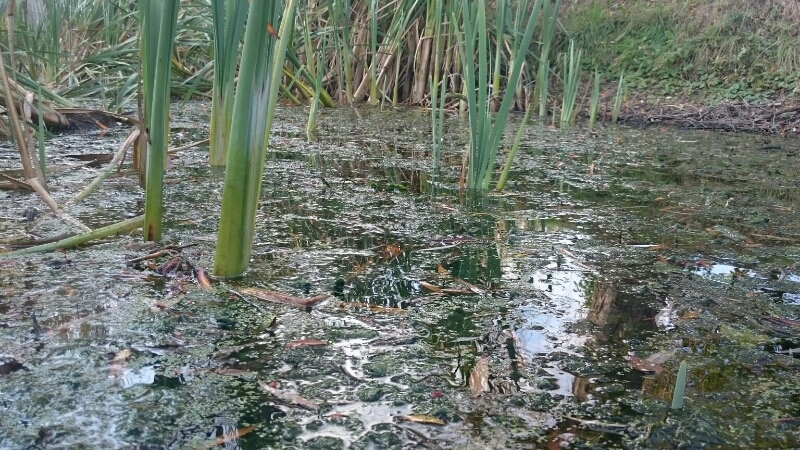Cabomba caroliniana A. Gray (U.S.A.) – A rare but increasing escape from cultivation or throw-out. For quite a long time only known with certainty from two locations, both in Flanders: discovered in Holsbeek in 1998 in an abandoned fishing pond in Populus woodland (Verloove 2002, Denys & al. 2003, Denys 2006). There, it grows along with rare native species viz Myriophyllum verticillatum and Potamogeton acutifolius and is not considered to be invasive at present. It is unknown whether or not Cabomba caroliniana has survived the severe winters of 2008-2012. In 2013 a massive population of Cabomba caroliniana was furthermore discovered in a canal in Sint-Pauwels (Wallenhof), near Sint-Gillis-Waas (Scheers & al. 2016). Since then it was reported from other areas as well (Scheers & al. 2019).
The initial apparent rarity of Cabomba caroliniana in Belgium was very remarkable. In the Netherlands it proved to be very hardy and locally very invasive (van Valkenburg & Rotteveel 2010, Matthews & al. 2013). A distribution map for this species in the Netherlands is available here: http://www.verspreidingsatlas.nl/5533. It may have been overlooked for a while in Belgium but now also shows signs of invasive behavior (Scheers & al. 2019).
Cabomba caroliniana is an unshowy submerged plant and might therefore pass unrecorded. Non-flowering specimens are rather reminiscent of species of Ceratophyllum or Myriophyllum.
Additional information on the incipient invasion of Cabomba caroliniana in western Europe is provided by Q-Bank at: http://www.q-bank.eu/Plants/BioloMICS.aspx?Table=Plants%20-%20Species&Re....


Selected literature:
Deng B.Y. (2000) Cabomba Aublet. (Cabombaceae), a newly naturalized genus of China (in Chinese). Acta Phytotax. Sin. 38(2): 198-200.
Denys L. (2006) Cabomba caroliniana. In: Van Landuyt W., Hoste I., Vanhecke L., Van den Bremt P., Vercruysse W. & De Beer D., Atlas van de flora van Vlaanderen en het Brussels gewest. Instituut voor Natuur- en Bosonderzoek, Nationale Plantentuin van België en Flo.Wer: 206.
Denys L., Packet J., Weiss L. & Coenen M. (2003) Cabomba caroliniana (Cabombaceae) houdt stand in Holsbeek (Vlaams-Brabant, België). Dumortiera 80: 35-40.
Gates B.N. (1958) Cabomba caroliniana grows in Worcester County, Massachusetts. Rhodora 60: 321-323.
Hanlon C. (1990) A Florida native – Cabomba (fanwort). Aquatics 12: 4-6.
Hodgdon A.R. (1959) Cabomba caroliniana in Rockingham County, New Hampshire. Rhodora 61: 248-249.
Hogsden K.L. (2007) The impacts of the non-native macrophyte Cabomba caroliniana on littoral. Journal of Great Lake Research 33: 497-504.
Hussner A., Haese U., van de Weyer K. & Kröning P. (2010) Cabomba caroliniana (Cabombaceae) – neu für Deutschland. Florist. Rundbriefe 43: 17-23. [available online at: http://www.lanaplan.de/download/Cabomba.pdf]
Ito M. (1986) Studies in the floral morphology and anatomy of Nymphaeales III. Floral anatomy of Brasenia schreberi Gmel. and Cabomba caroliniana A. Gray. Bot. Mag. (Tokyo) 99: 169-184.
Jin X., Ding B., Gao S. & Jiang W. (2005) Invasion and spreading of Cabomba caroliniana revealed by RAPD markers. Chinese Journal of Oceanology and Limnology 23: 406-413.
Köder M., Sipos V., Zeltner G.H. & Kohler A. (1999) Cabomba caroliniana Gray – ein Neophyt in ungarischen Gewässern. In: Deutsche Gesellschaft für Limnologie, Tagungsbericht 1998 (Klagenfurt): 650-654.
Mackey A.P. & Swarbrick J.T. (1997). The biology of Australian weeds 32. Cabomba caroliniana Gray. Plant. Prot. Q. 12: 154-165.
Matthews J., Beringen R., Lamers L.P.M., Odé B., Pot R., van der Velde G., van Valkenburg J.L.C.H., Verbrugge L.N.H. & Leuven R.S.E.W. (2013) Risk analysis of the non-native Fanwort (Cabomba caroliniana) in the Netherlands. [available online at: https://www.vwa.nl/onderwerpen/risicobeoordelingen/bestand/2204185/risk-...
McCracken A., Bainard J.D., Miller M.C. & Husband B.C. (2013) Pathways of introduction of the invasive aquatic plant Cabomba caroliniana. Ecol. Evol. 3(6): 1427-1439. [available online at: http://www.ncbi.nlm.nih.gov/pmc/articles/PMC3686180/]
McDonald F. (2002) Canada’s response to the introduction of fanwort in Ontario waters: A case study: 161-167. In Claudi R. & al. (eds.), Alien invaders in Canada’s waters, wetlands and forests. Natural Resources Canada, Canadian Forest Service Science Branch, Ottawa, ON.
Noël J. (2004) Growth, reproduction and control of an invasive plant, Cabomba caroliniana in Kasshabog Lake, Ontario and its potential dispersal. M.Sc. thesis, Trent University, Peterborough, ON: X + 89 pp.
Sanders D.R. (1979) The ecology of Cabomba caroliniana in: Gangstad E.O. (ed.), Weed Control Methods for Public Health Applications, CRC Press, Boca Raton, Florida: 133-146.
Scheers K., Denys L., Packet J. & Adriaens T. (2016) A second population of Cabomba caroliniana Gray (Cabombaceae) in Belgium with options for its eradication. BioInvasions Records 5(4) [available online at: https://data.inbo.be/pureportal/files/12474476/BIR_2016_Scheers_etal.pdf]
Scheers K., Denys L., Jacobs I., Packet J., Smeekens V. & Adriaens T. (2019) Cabomba caroliniana Gray (Cabombaceae) invades major waterways in Belgium. Knowl. Manag. Aquat. Ecosyst. 420, 22. [available online at: https://www.kmae-journal.org/articles/kmae/full_html/2019/01/kmae190014/...
Schneider E.L. & Jeter J.M. (1982) Morphological studies of the Nymphaeaceae: 12. The floral biology of Cabomba caroliniana. Amer. J. Bot. 69(9): 1410-1419.
Schooler S., Julien M. & Walsh G.C. (2006) Predicting the response of Cabomba caroliniana populations to biological control agent damage. Australian Journal of Entomology 45: 327-330.
Steták D. (2004). An aquarium plant in natural waters and canals of Hungary: The fanwort (Cabomba caroliniana). Kitaibelia 6: 165-171. [available online at: http://kitaibelia.unideb.hu/articles/Kitaibelia_vol91_p165-171.pdf]
Van Valkenburg J. & Rotteveel T. (2010) Cabomba caroliniana Gray, een subtropische verrassing in Loosdrecht. Gorteria 34: 106-118.
Verloove F. (2002) Ingeburgerde plantensoorten in Vlaanderen. Mededeling van het Instituut voor Natuurbehoud n° 20: 227 p.
Vukov D., Jurca T., Rućando M., Igić R. & Miljanivić B. (2013) Cabomba caroliniana A. Gray 1837 – A new, alien and potentially invasive species in Serbia. Arch. Biol. Sci., Belgrade 65(4): 1515-1520. [available online at: http://www.doiserbia.nb.rs/img/doi/0354-4664/2013/0354-46641304515V.pdf]
Wilson C.E., Darbyshire S.J. & Jones R. (2007) The biology of invasive plants in Canada. 7. Cabomba caroliniana A. Gray. Can. J. Plant Sc. 87: 615-638. [available online at: http://pubs.aic.ca/doi/pdf/10.4141/P06-068]
Zhung X., Zhong Y. & Chen J. (2003) Fanwort in eastern China: An invasive aquatic plant and potential ecological consequences. Ambio 32: 158-159.

